This article dives into some essential Discrete Trial Training (DTT) techniques that you, as a parent, can use to support your child's learning through ABA therapy. It’s all about finding what works best for your little one! Personalized approaches, structured learning, and your involvement as a caregiver are key. When DTT is tailored to fit your child's needs, it can really boost their skill acquisition and motivation, especially for children with autism.
Let’s face it, navigating the world of ABA therapy can be challenging. You might wonder how to make learning engaging for your child. Think about those moments when your child lights up at a new skill or concept—they’re so rewarding! By focusing on DTT techniques, you can create those moments more often. Remember, you’re not alone in this journey; many parents share similar experiences.
So, what can you do? Start by exploring DTT techniques that resonate with you and your child. It’s all about building a connection and making learning fun! We’re here to help you every step of the way. Let’s explore this together and see how personalized DTT can make a difference in your child’s learning journey!
In the world of autism support, Discrete Trial Training (DTT) really shines as a key method. It offers a structured way for kids to learn new skills, making their educational experiences more enriching. As parents, you have a wonderful chance to learn essential DTT techniques, which means you can actively participate in your child's learning journey.
But let’s be honest—navigating the ins and outs of DTT can feel a bit overwhelming. You might wonder, how can you make sure this approach truly meets your child's unique needs? And how can it help them grow and become more independent?
These are important questions, and you’re not alone in asking them! Let’s explore this together and find the best ways to support your child.
Rori Care - ABA Trials takes a personalized approach to ABA therapy through Discrete Trial Training (DTT). This technique breaks down skills into manageable parts, tailored to each child's unique needs. It focuses on teaching essential social skills like making eye contact, sharing, taking turns, and reading facial expressions. This way, every young person can enjoy the best educational experience possible, boosting their engagement and skill development.
DTT is all about clear goals, helping kids grasp complex ideas through repetition and positive reinforcement. This customized approach not only improves learning outcomes but also builds confidence as children achieve small, gradual successes. Did you know that research shows 90% of kids make significant progress when they receive the recommended hours of therapy with active caregiver involvement? This highlights how crucial a tailored approach and the role of caregivers are in the ABA trials process.
For parents, understanding this personalized approach is key. It allows you to actively engage in your child's learning journey. By ensuring that therapy aligns with your child's specific developmental goals, you can reinforce the skills learned during sessions at home, making the intervention even more effective. Clinicians emphasize that when DTT programs are consistently adjusted based on careful observation, the ABA trials demonstrate that children steadily progress toward their goals. This really showcases the transformative potential of personalized ABA trials.
Plus, using visual supports in DTT helps autistic individuals better understand instructions, enhancing their learning experience. This comprehensive method not only improves behavioral outcomes but also equips caregivers with the knowledge and skills needed to support their child's development effectively.
Let’s explore this together! We’re here to help you every step of the way!
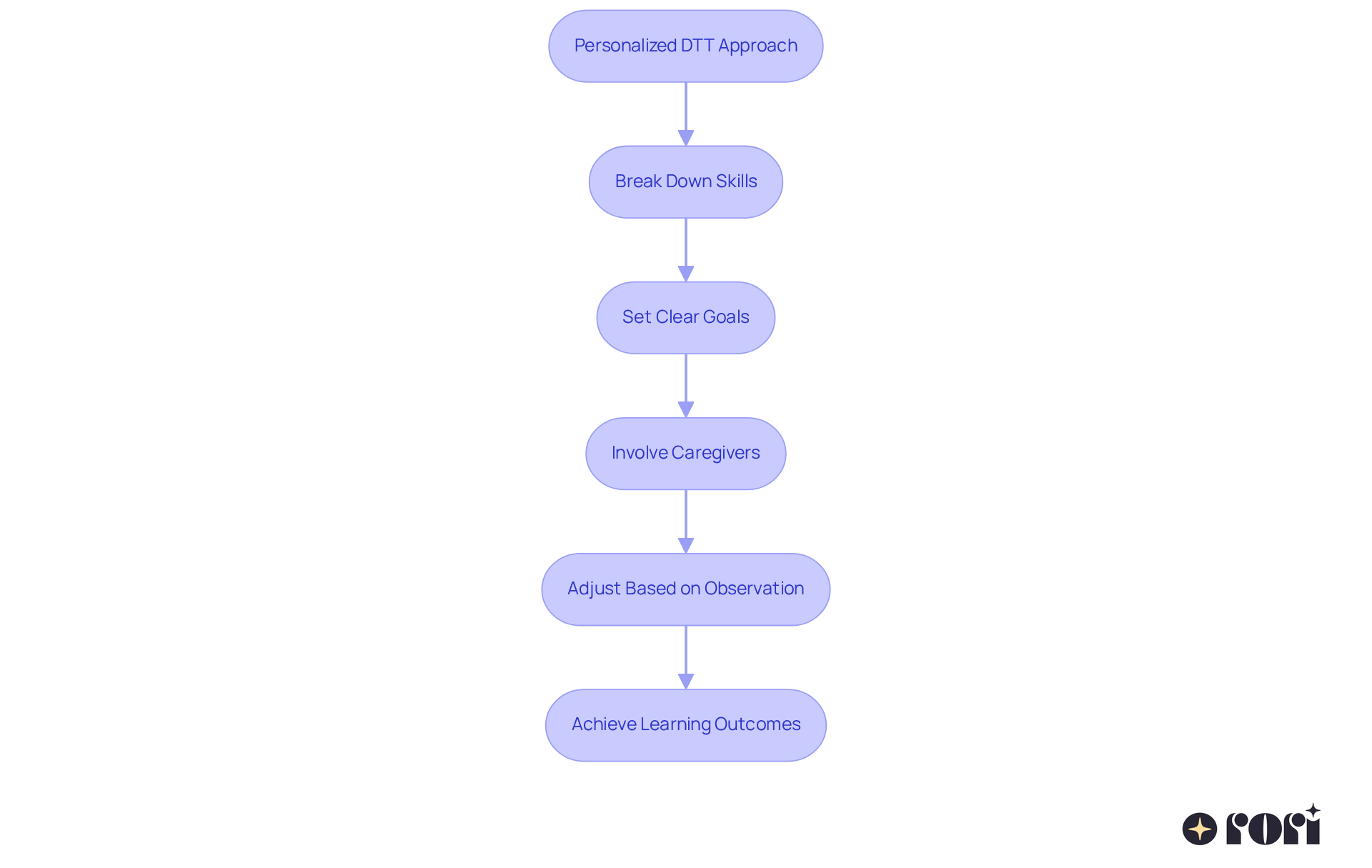
Discrete Trial Training (DTT) is a fantastic teaching method that is a key part of ABA trials. It breaks down skills into bite-sized pieces, making learning more manageable for kids. Each trial follows a simple five-step process:
Understanding these principles helps you see how DTT works and highlights the importance of consistency and structure in your child’s learning journey. With this knowledge, you can easily replicate DTT techniques at home, reinforcing what your child learns during therapy sessions.
Recent studies show that DTT is effective in improving social skills and behavioral responses in children with autism through ABA trials. This makes it a valuable tool for parents looking to support their child's development.
To get started with DTT at home, try using simple prompts and giving immediate feedback. Keeping a structured environment that mirrors therapy sessions can really boost your child’s learning experience.
Let’s explore this together! You’ve got this, and we’re here to help you every step of the way!

Discrete Trial Training (DTT) offers some fantastic benefits for individuals with autism, especially when it comes to picking up new skills and staying motivated. At Rori Care, our clinical leadership team is all about promoting neurodiversity and empowering caregivers with ABA principles and strategies to help their kids reach their behavioral goals. Let’s dive into some of the key advantages of DTT:
These benefits really showcase how effective DTT can be as a powerful tool in ABA trials, making it a preferred choice for both clinicians and parents. Research shows that kids who engage in DTT often demonstrate faster skill acquisition rates, with many feeling more motivated in structured learning environments, such as during ABA trials. This organized approach not only aids in mastering skills but also promotes a positive educational experience, which is essential for fostering long-term growth. At Rori Care, we believe that empowering caregivers through education and support is key to achieving these positive outcomes.
Let’s explore this together! We’re here to help you every step of the way!
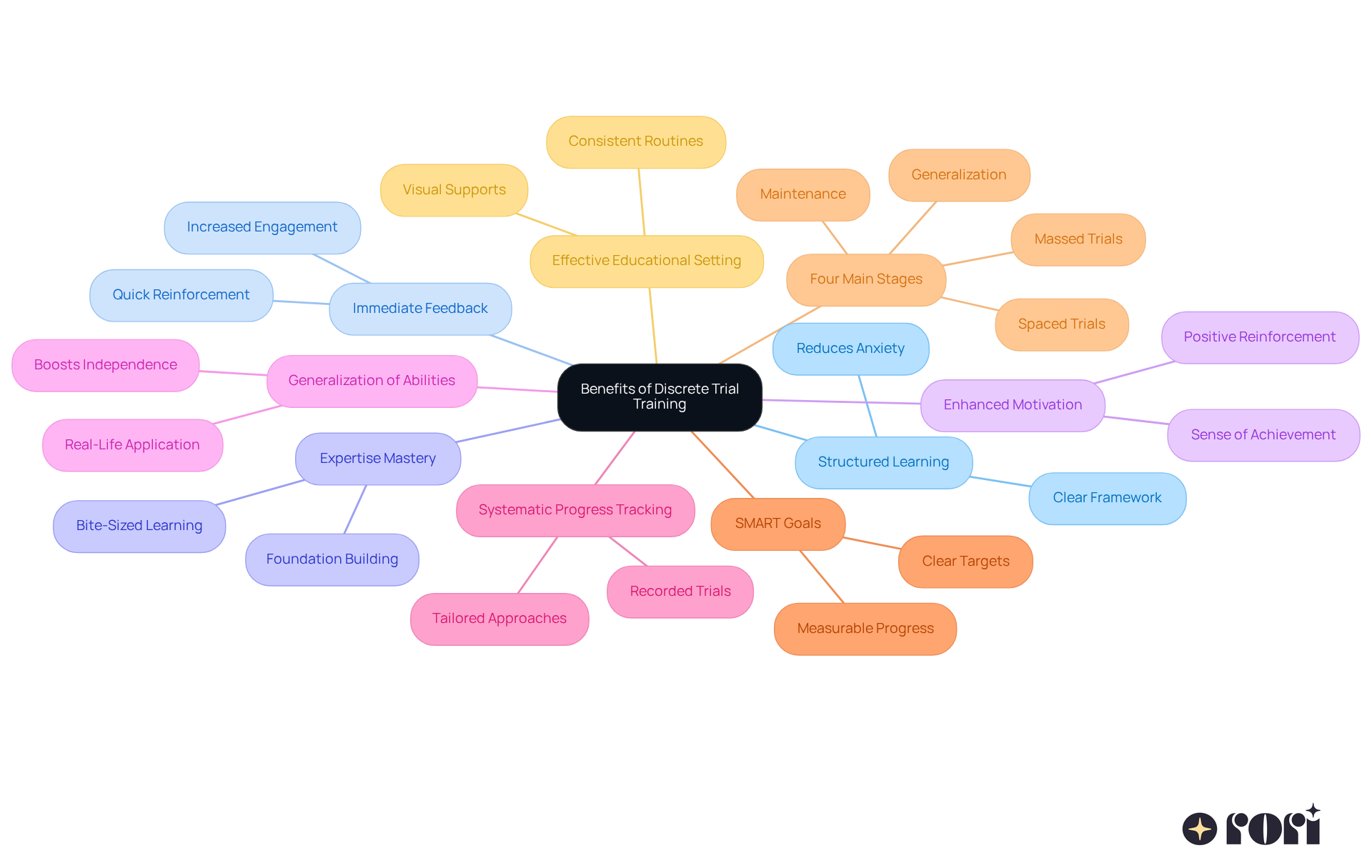
To effectively implement Discrete Trial Training (DTT) at home, parents can follow these practical steps:
By following these steps, you can create a nurturing educational atmosphere that boosts your child’s therapy, fostering growth and confidence. One parent shared, "Through organized planning and careful monitoring, I’ve seen my child flourish with DTT at home." This approach not only empowers you as a parent but also enhances the overall effectiveness of ABA trials, which are the only scientifically proven treatment for autism covered by insurance. Studies show that with the right training and ongoing data collection, parents can successfully implement DTT at home during ABA trials, leading to more accurate responses from kids and better generalization of skills. Remember, achieving meaningful progress with DTT takes dedication and consistency. Early intensive behavioral intervention (EIBI) is crucial for improving education, verbal, and social skills in children with autism, making these steps essential for effective implementation.
Let’s explore this together! We’re here to help you every step of the way!
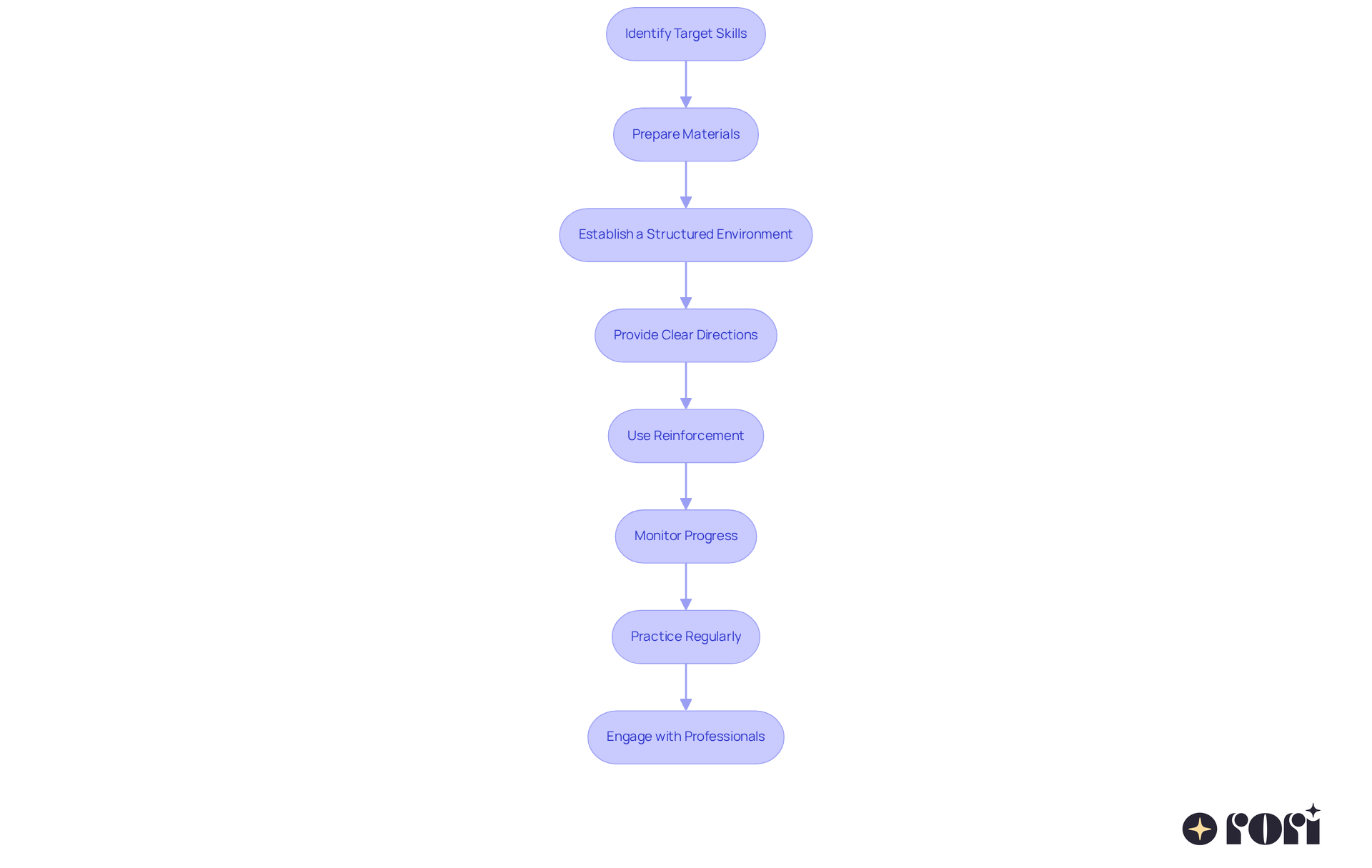
While Discrete Trial Training (DTT) is recognized as a helpful approach for teaching kids with autism, it does come with its own set of challenges that parents should be aware of. Let’s take a closer look at some key concerns:
Repetitive Nature: DTT’s structured and repetitive format might not capture the interest of every child, especially those who thrive in more dynamic learning environments. Behavioral specialists often point out that while this structure has its benefits, it can feel a bit unnatural and may not resonate with every learner.
Limited Generalization: Skills learned in a controlled setting often struggle to make the leap to real-world situations. Research shows that we need additional strategies to help kids apply what they learn through DTT in their everyday lives.
Potential for Over-Dependence: There’s a chance that kids might become too reliant on prompts and reinforcement. To foster independence, it’s important to gradually reduce these supports, helping them learn to respond without needing external cues.
Criticism of Rigidity: Some critics argue that DTT can be too rigid, which might stifle creativity and natural learning processes. This inflexibility can lead to disengagement, so it’s essential for parents and therapists to adapt the method to fit each child’s unique learning style.
By recognizing these challenges, parents can approach DTT with a thoughtful mindset, tailoring the method to suit their child’s individual needs and preferences. Plus, caregiver education is crucial in this journey. For example, training can equip caregivers with strategies to make DTT more engaging—like incorporating play-based elements or changing up the learning environment.
By enhancing support, making informed decisions, and improving behavioral outcomes, caregivers can feel empowered to actively participate in their child’s development. This adaptability is key to boosting the effectiveness of DTT and supporting their child’s growth.
Let’s explore this together! We’re here to help you every step of the way!
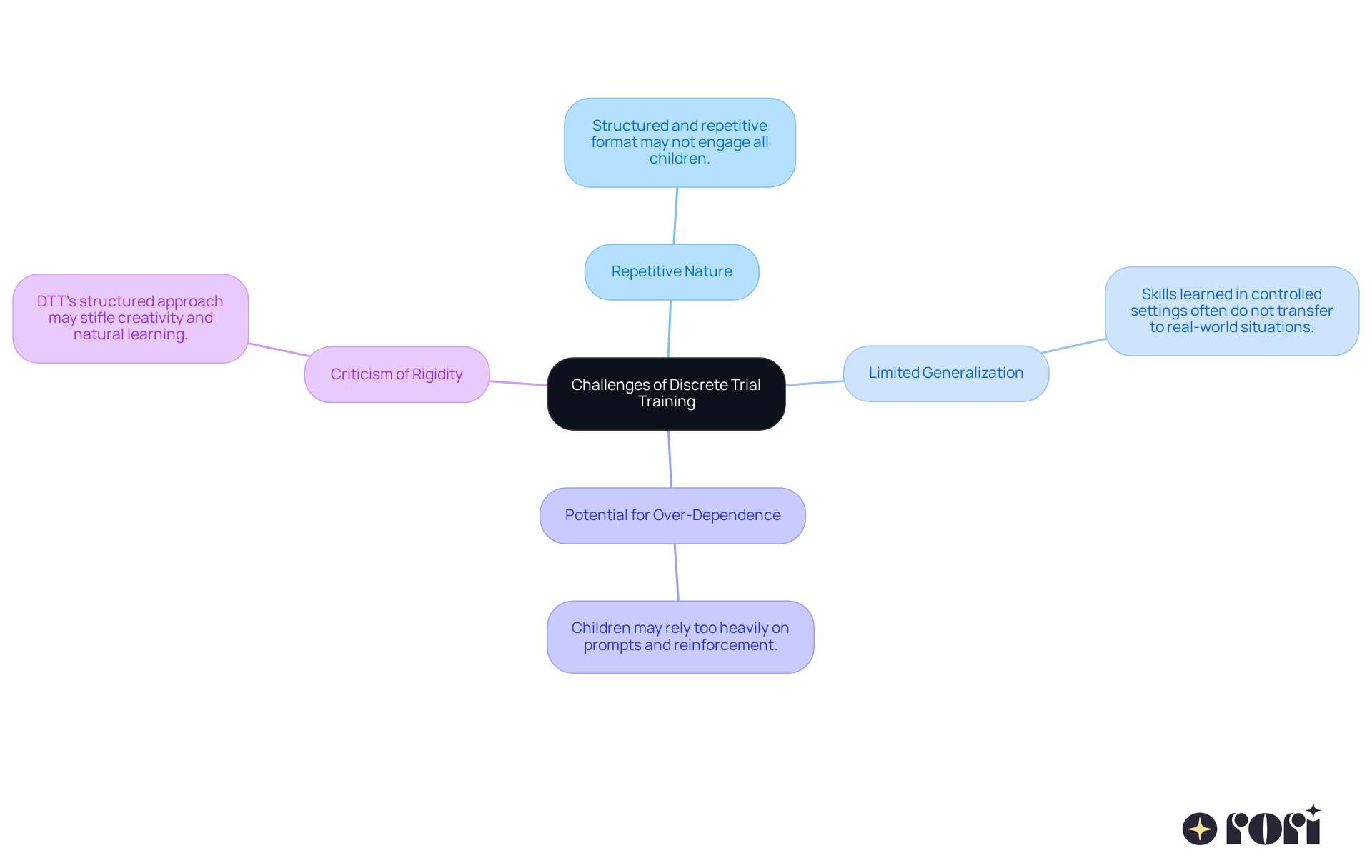
Data collection is super important in aba trials, particularly in Discrete Trial Training (DTT). It helps parents and therapists measure progress effectively and make informed decisions about interventions. Let’s break down some key components of data collection:
By actively engaging in data collection during aba trials, parents can gain valuable insights into their child’s educational journey. This not only enhances the effectiveness of DTT but also fosters a collaborative approach to therapy.
So, let’s explore this together! Your involvement makes a difference!
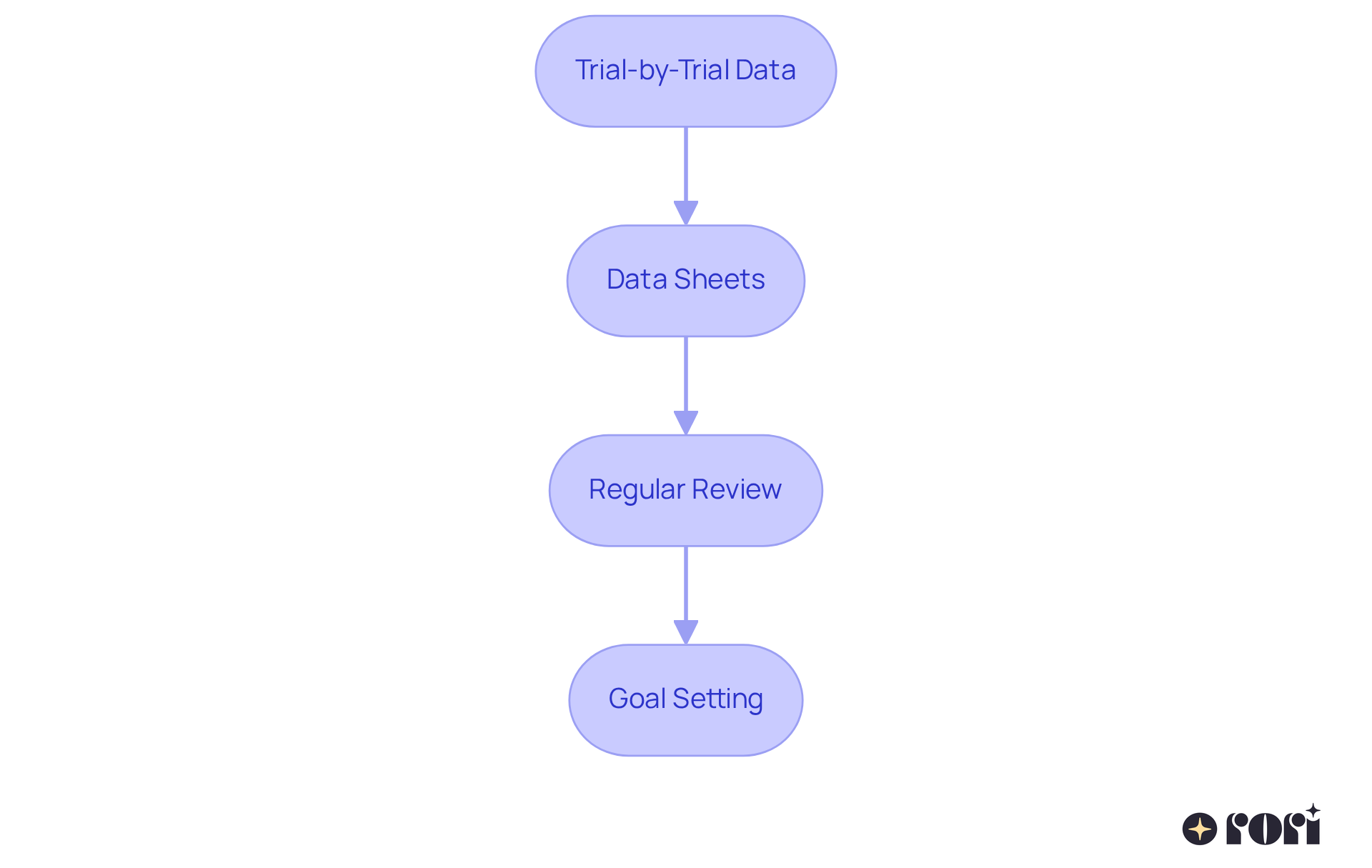
Adapting Discrete Trial Training (DTT) to fit individual needs is so important for making it truly effective. Let’s dive into some friendly strategies for customization:
Research suggests that customized ABA trials can lead to significant improvements in cognitive abilities, communication skills, and social interactions. For instance, studies indicate that ABA trials demonstrate an impressive success rate of over 89% in helping children with autism. By personalizing DTT, you can create a more effective and enjoyable learning environment, paving the way for greater success in skill acquisition and overall growth.
Let’s explore this together! We’re here to help you every step of the way!

Reinforcement is a key part of Discrete Trial Training (DTT), and it’s all about motivating our little learners to engage and learn effectively. Let’s dive into some friendly strategies to boost motivation during DTT sessions, with a special focus on how caregivers can get involved:
By applying these reinforcement strategies and actively involving caregivers, parents can create a positive learning environment that motivates their children to engage in DTT sessions. This ultimately leads to significant advancements in their skills and behaviors. Let’s explore this together!
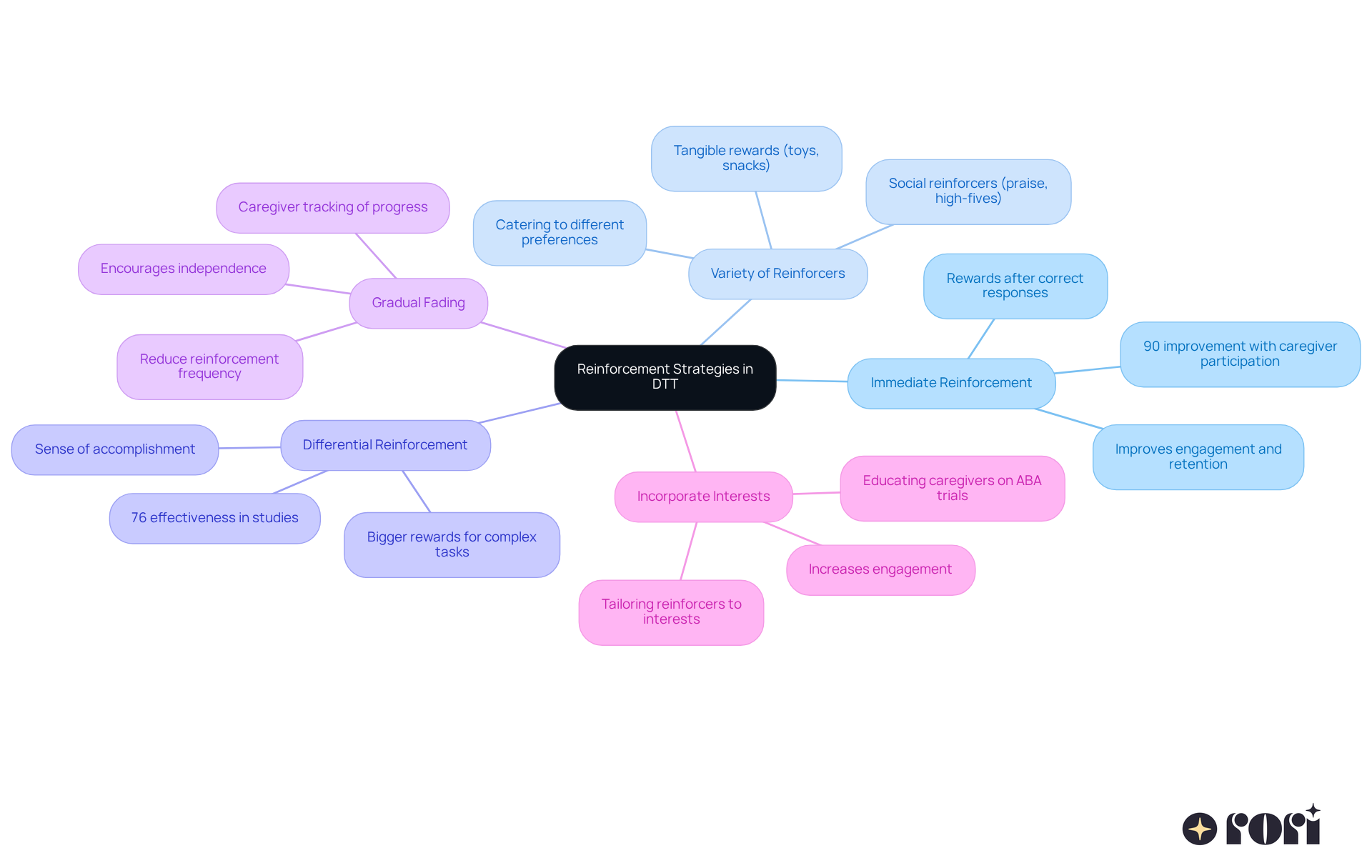
Generalization is all about helping our kids use the skills they’ve learned through Discrete Trial Training (DTT) in different places and situations. As parents, there are some great strategies we can use to encourage this, especially when we get a little help through caregiver education:
Research shows that generalization is a key part of effective ABA trials. It ensures that the skills learned in structured settings actually translate into real-life abilities, especially during ABA trials. In fact, out of nine randomized controlled trials (RCTs) reviewed, eight showed effective generalization across different practitioners, settings, and everyday activities. By focusing on generalization, we can empower our kids not just to learn essential skills but to apply them successfully in the real world.
Plus, through caregiver training, we gain a deeper understanding of ABA principles and strategies, which enhances our ability to support our kids’ educational and behavioral goals. This active involvement not only leads to better behavioral outcomes but also fosters greater independence and improves the overall quality of life for our children.
Let’s explore this together! We’re here to help you every step of the way!

Technology is really changing the game for Discrete Trial Training (DTT) by introducing exciting tools such as aba trials that can make education more engaging and effective. Let’s take a look at some of these advancements that can truly help your child thrive:
By embracing these tech advancements, you can really enhance your child’s DTT experience, making learning not just effective but also enjoyable! So, why not dive in and explore these tools together? Engaging with them consistently can make a world of difference in your child’s learning journey. We’re here to help you every step of the way!

Mastering Discrete Trial Training (DTT) can truly be a rewarding journey for both parents and their children, especially in the world of ABA therapy. By embracing a personalized approach, you can significantly enhance your child's learning experiences, making sure that every step is tailored to their unique needs. This method not only helps kids acquire new skills but also builds their confidence and independence.
Let’s talk about the core principles of DTT. It’s all about having a structured framework that promotes effective learning through repetition and positive reinforcement. Think about it:
Of course, challenges may pop up, like the risk of over-dependence on prompts, but remember, collecting data is invaluable for tracking progress and guiding interventions.
The importance of personalized DTT really can’t be overstated. By actively engaging in your child's learning journey and using innovative tools and strategies, you can create an enriching educational environment that encourages real-world application of skills. Your commitment to understanding and implementing these techniques not only paves the way for meaningful progress but also empowers your family to support your child's growth effectively.
So, why not embrace this opportunity? Together, we can make a lasting impact on your child's development and foster a brighter future through the power of ABA therapy. Let’s explore this journey together!
What is Rori Care's approach to ABA therapy?
Rori Care uses a personalized approach to ABA therapy through Discrete Trial Training (DTT), which breaks down skills into manageable parts tailored to each child's unique needs.
What skills does Discrete Trial Training (DTT) focus on teaching?
DTT focuses on teaching essential social skills such as making eye contact, sharing, taking turns, and reading facial expressions.
How does DTT improve learning outcomes for children?
DTT improves learning outcomes by setting clear goals, using repetition and positive reinforcement, which helps children grasp complex ideas and build confidence through small, gradual successes.
What role do caregivers play in the DTT process?
Caregivers play a crucial role in the DTT process as their active involvement is linked to significant progress in children, especially when therapy is tailored to the child's specific developmental goals.
What are the core principles of Discrete Trial Training?
The core principles of DTT include a five-step process: Antecedent (prompt), Behavior (response), Outcome (feedback), Inter-Trial Interval (break), and Reinforcement (positive encouragement).
How can parents replicate DTT techniques at home?
Parents can replicate DTT techniques at home by using simple prompts, providing immediate feedback, and maintaining a structured environment that mirrors therapy sessions.
What are the benefits of using DTT for children with autism?
Benefits of DTT include structured learning, immediate feedback, mastery of skills, enhanced motivation, generalization of abilities, systematic progress tracking, setting SMART goals, and creating a supportive educational setting.
How does DTT help with skill acquisition and motivation?
DTT helps with skill acquisition by breaking down complex tasks into smaller parts, providing immediate reinforcement, and fostering a sense of achievement, which motivates children to continue learning.
What is the significance of tracking progress in DTT?
Tracking progress in DTT is significant as it allows clinicians to monitor each child's development over time and ensure that the teaching approach is effective and tailored to their needs.
How does Rori Care support caregivers in the DTT process?
Rori Care supports caregivers by promoting education and providing strategies to help them effectively support their child's development through ABA principles and techniques.